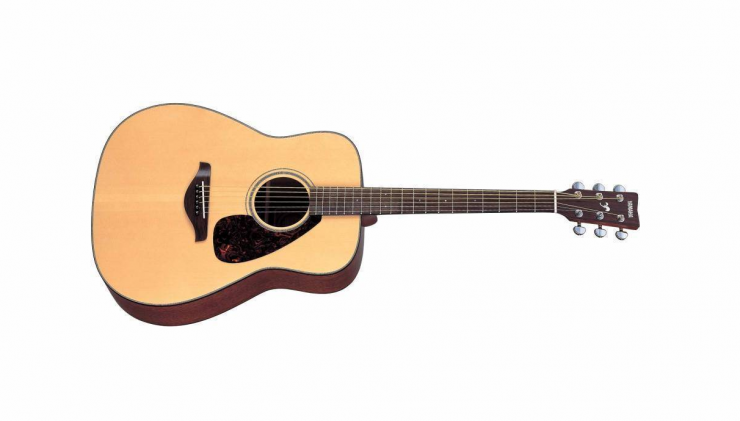Yamaha is a giant in the music industry that’s been around for over a century. It was founded in 1887 by Torakusu Yamaha, at which time they’ve mainly manufactured acoustic pianos and reed organs.
What’s interesting about them is the fact that they’ve been in the music scene before anybody else in the showbusiness did, and better yet, they’ve endured the trials and tribulations of time up to date. They’ve started out with keyboard instruments after which they’ve moved on to furniture, harmonicas, and various other audio equipment, only to start making guitars in the year of 1942.
Their genuine, innovative craftsmanship can be seen in virtually every model, every instrument they put out, and what would best describe their products would be ‘a perfect mix of tradition and cutting-edge technology’.
Yamaha FG700s Overview
Design
In short, Yamaha FG700S is pretty much synonymous with Yamaha’s traditional craftsmanship. It has a classic dreadnought body shape, a natural high-gloss finish, and as far as aesthetics are concerned, no detail is missing out.
High Gloss Natural Color Finish

Though there are people who prefer picking a color rather than being stuck with only the default option, it’s safe to say that Yamaha FG700S was done in the best way possible. It’s simplicity accentuates the tortoise pickguard and the beauty of the rosewood fingerboard, to say the very least.
Dreadnought Body
Dreadnought is the third biggest guitar body type, and that means several things here. First and foremost, that means that Yamaha FG700S is slightly heavier than average, but on the plus side, it’s easier to hold it.
The frets are also slightly bigger, and the FG700s could easily pass on as a beginner guitar, even though it’s not one originally. On a side note, the bigger the body is, the more room there will be for reverberations, but we’ll talk about that in the ‘sound’ section.
Sound
One of the best parts about Yamaha FG700S is how it sounds. Namely, it comes outfitted with some of the finest tonewoods which provide an exceptionally warm, full tone in combination. The nato body also provides it with a very exquisite sonic signature. In essence, all you need to know is that Yamaha FG700S excels in this field of performance the most.
Full Bodied Sonic Performance
In short, the FG700s provides a very thick, natural sound. It’s a very big guitar with a rather small soundhole which brings forth the airy resonance and accentuates the highs more than most. Fingerstyle or picked, the FG700 provides a rich, full bodied sound, which is definitely one of the most important benefits it brings to the table.
High Overall Volume
It’s pretty obvious that a dreadnought body type guitar has a higher volume than the smaller ones. Yamaha’s FG 700s has such an intense delivery that you might need to take it a bit easier until your parents, roommates, or pretty much even yourself get accustomed to it.
Well suited for numerous playing styles and music genres
Even though this guitar has a full, distinguishable sound, it’s fairly safe to say that it’s also very versatile. Most of its tone comes from the very specific type of tonewood combination, but what’s very authetnic about it is that it’s incredibly responsive.
What that means is that it can be loud, bright, dark, warm, or pretty much anything you want it to be, depending on how you play it.
Awesome Sustain
Although this particular of tonewoods never intended to provide the biggest sustain ever, it’s pretty nice for the price. What brings it down a bit is the tiny soundhole, but what keeps it so pronounced is the sheer quality of wood used in the construction process.
Build
Sonically, aesthetically, and durability wise, Yamaha’s FG 700s is built like a brick. This guitar was most certainly built to last at least several decades, and you can rest assured that accidental dents and falls won’t ruin it. What we’re more interested in are the tonewoods, including a solid spruce top, rosewood fingerboard, and the nato body.
Solid Spruce Top
First of all, we should break this down – the top of Yamaha’s FG 700s is solid, made of spruce material. These are two separate terms which are often put together because they relate to the same thing.
So, a solid top is basically made of a single piece of wood, whereas the opposite would refer to ply-wood, or multiple pieces glued together. In most cases, going for an all-solid construction is better as it provides a decent punch in the tone.
Now, as for the spruce part, it would be fair to say that this particular material is rather common. It sounds very bright and somewhat clearer than most top materials (for instance, it’s much brighter than Ceda).
Rosewood Fingerboard

Rosewood is a very peculiar tonewood. It’s sweet and very warm, and in comparison to the second most used fingerboard material –Maple- it’s softer and offers more playability. Starts and Telecasters are the two most common examples of rosewood fingerboard guitars.
The sheer warmth of rosewood makes it very versatile, but the bad thing about it is that it underperforms when it comes to playing a specific genre. Being too warm and bright, it evens out the harsh edges but lacks the authenticity and boldness that, perhaps Maple could’ve given you.
Nato Body
Nato, or ‘eastern mahogany’ as some call it, is a fairly available tonewood type, for the lack of better words. It’s far from being anywhere near exotic, and some people even go as far as to say that it’s cheaper, a substitute for standard, traditional mahogany.
While there may be some truth to it, Nato is all but ‘low quality’ tonewood. It provides a substantial boost to the depth, warmth, and crispness to the sound, which some people might not like, but it’s far from being bad per se.
Notably, traditional mahogany has a richer lower end, hence the basses pull through a bit more naturally. Nato does a superb job at putting up exceptionally great, pronounced highs and decent mids.
Chromed Tuning Pegs

The chromed hardware on the Yamaha’s FG 700s is not, perhaps, exemplary, but it does the job quite great. The machine heads hold the tune nice, and they are exceptionally easy to use. Since they provide sufficient reliability, it would be best to perceive them as an aesthetic element.
Price & Price point category
We can’t say that Yamaha’s FG 700s is cheap, but it’s certainly not as expensive as, for example, most Taylor dreadnoughts. This guitar does belong to the moderately expensive price point category, but saving up for it shouldn’t take too much time.
In terms of value, the cost shouldn’t be too important here, as this guitar just brings so many benefits to the table that it’s absurd. With massive playability and absolutely breath-taking sound quality, you shouldn’t think twice about giving it a shot.
The good and bad about Yamaha FG700S
Although there are plenty of things you’ll simply love about Yamaha’s FG 700s, there are a couple of them that you won’t like so much.
For example, most people don’t like the Nato body material at first, but they do grow to love it eventually. The big sound of this guitar might also mean that you’ll need to invest some time in learning how to play more quietly or simply pay for a studio.
Additionally, there’s way too much brightness in the tone for some people, although, from an objective point of view, the responsiveness of this guitar makes it capable of producing the exact type of tone you want, so it falls down to your skill level.
That leads us to another potential flaw. Basically, more and more people are labeling this guitar as beginner’s guitar, although that’s not necessarily what it actually is. Sure, it doesn’t cost that much and it has a high level of playability, but in order to utilize the plethora of its good sides, you’ll need at least some skill with this type of instrument.
Now, there’s a huge silver lining here in case you’ve got a negative impression based on the ‘bad things about Yamaha’s FG 700s’. There are so many good ones that it would take forever to state them all out.
Apart from the huge volume, great sustain, awesome sound, and a terrific price, the versatility of this guitar is something that makes it so desirable. Namely, it’s equally good for beginners and pros, and it’s suited for practically any music playing style or genre. Some say it’s one of the best acoustic guitars out there.
Final Verdict
We’ve just stated some of the reasons why millions and millions of guitar players like Yamaha’s FG 700s so much. It’s true that it’s not for everybody, as we explained in the sections above, it just has a lot of specific characteristics that might not appeal to just everyone. However, those who know what they want and find it in Yamaha’s FG 700s know how to appreciate the many benefits and advantages it provides.












Add comment